Acer R7 Review: Something Different
by Jarred Walton on August 15, 2013 12:45 AM ESTI’m going to stuff all of the benchmarks onto one page for this review; there’s really nothing noteworthy about the performance of the R7, at least on the CPU and graphics side of things. Battery life and display quality are a bit more important, but given the timeliness of this review (or the lack thereof), most of what we wanted to say was covered on the previous pages. So, here are the benchmarks, using our updated 2013 mobility suite. I’ll save a bit of short commentary for after the break.
First, here’s a quick overview of the laptops we’re including in our graphs. With the update to our 2013 mobile test suite, we’re somewhat at the mercy of our results database. Most of our comparisons that are meaningful are going to be with Ultrabooks, and given that were dealing with basically Ultrabook hardware the Acer R7 posts similar performance. We tossed in the MSI GX60 Richland APU notebook as a comparison, not because the notebooks are similar but because the A10-5750 APU more or less competes with Ivy Bridge ULV processors. Note that we did not run every benchmark on every laptop, so some charts might be missing certain laptops.
| Specifications of Benchmarked Laptops | ||||||
| Laptop | CPU | GPU | Storage | RAM | LCD | Battery |
| Acer R7-571-6858 | Intel Core i5-3317U | HD 4000 | 500GB HDD + 24GB SSD | 1x4GB + 1x2GB | 15.6” 1080p Glossy AHVA Touchscreen | 4-cell 54Wh |
| Acer S7-391-9886 | Intel Core i7-3517U | HD 4000 | 2x128GB RAID 0 SSDs | 2x2GB | 13.3” 1080p Glossy IPS Touchscreen | 4-cell 35Wh |
| Acer S7-392-9890 (Preview) | Intel Core i7-4500U | HD 4400 | 2x128GB RAID 0 SSDs | 2x4GB | 13.3” 1080p Glossy IPS Touchscreen | 4-cell 46Wh |
| AMD Kabini | AMD A4-5000M | HD 8330 | 256GB SSD | 1x4GB | 14” 1080p Matte IPS | 4-cell 45Wh |
| Apple MacBook Air 13 (2013) | Intel Core i5-4250U | HD 5000 | 128GB SSD | 2x2GB | 13.3” 1440x900 Glossy TN | 4-cell 54Wh |
| Clevo W550EU (Mythlogic) | Intel Core i5-3340M | HD 4000 | 256GB SSD | 2x4GB | 15.6” 1080p Matte IPS | 6-cell 62-Wh |
| HP Spectre XT TouchSmart | Intel core i7-3517U | HD 4000 | 500GB HDD + 32GB SSD | 2x4GB | 15.6” 1080p Glossy IPS Touchscreen | 4-cell 48Wh |
| Lenovo ThinkPad X1 Carbon | Intel Core i5-3427U | HD 4000 | 180GB SSD | 2x2GB | 14” 1600x900 Glossy TN Touchscreen | 4-cell 45Wh |
| MSI GE40 | Intel Core i7-4702MQ | HD 4600 / GTX 760M | 128GB SSD + 750GB HDD | 1x8GB | 14” 1600x900 Matte TN | 6-cell 65Wh |
| MSI GX60 | AMD A10-5750 | HD 8650G | 750GB HDD | 1x8GB | 15.6” 1080p Matte TN | 9-cell 87Wh |
| Toshiba KIRAbook | Intel Core i7-3537U | HD 4000 | 256GB SSD | 2x4GB | 13.3” 2560x1440 Glossy IPS Touchscreen | 4-cell 52Wh |
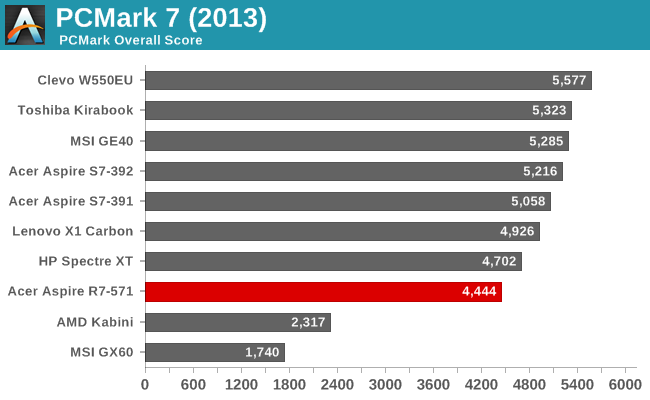
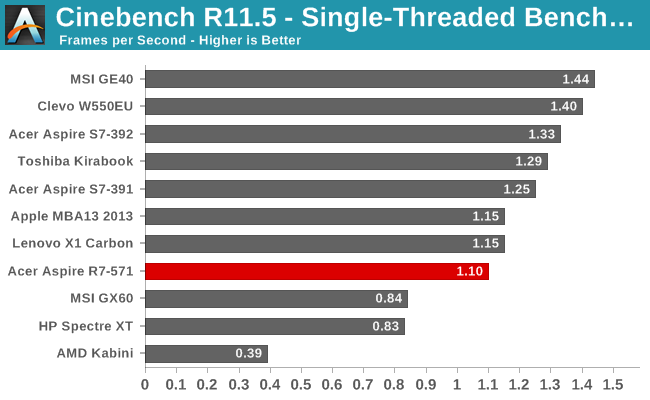
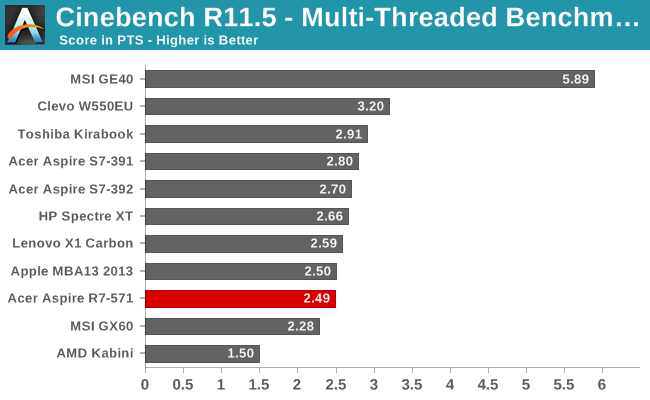
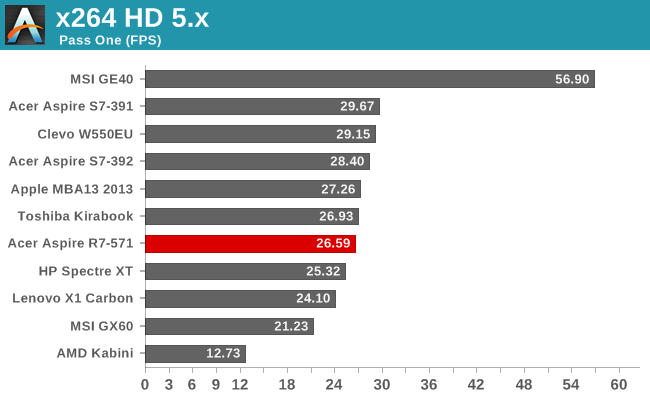
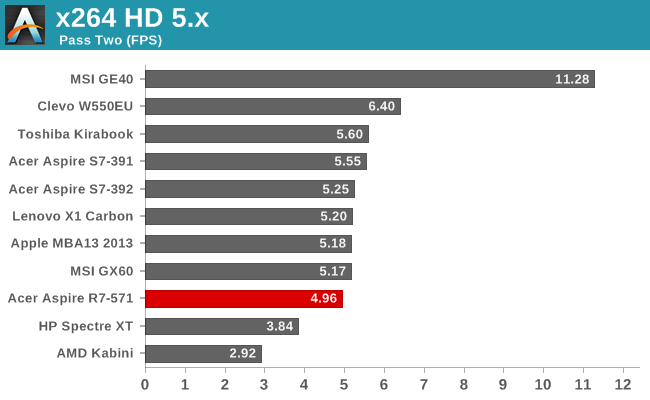
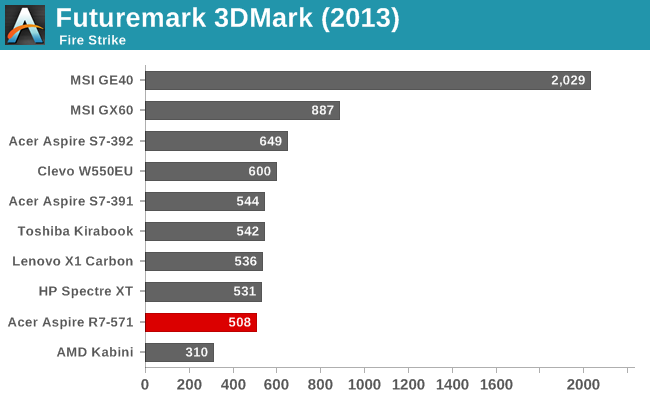


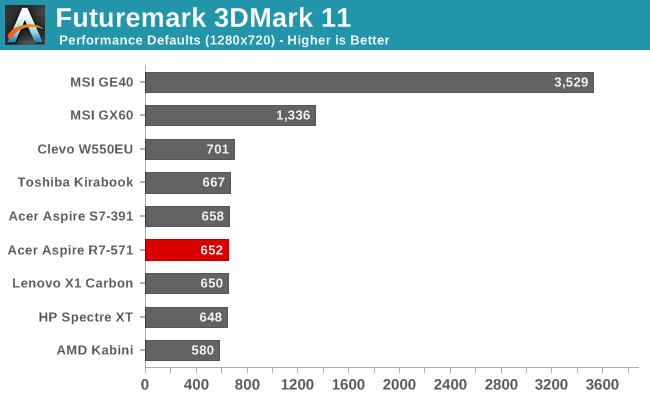
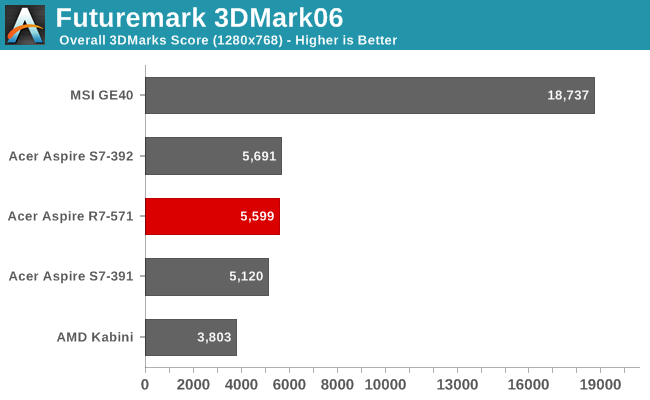

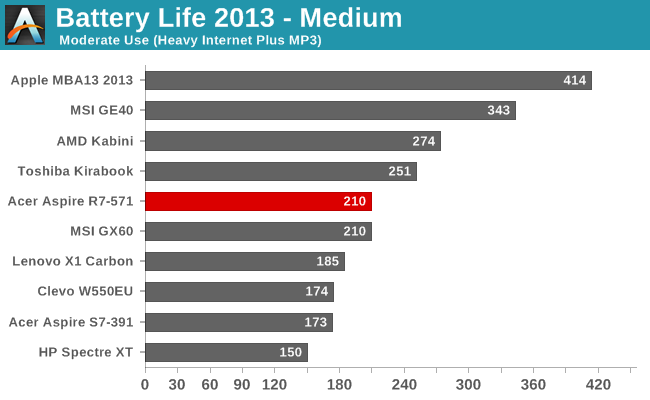
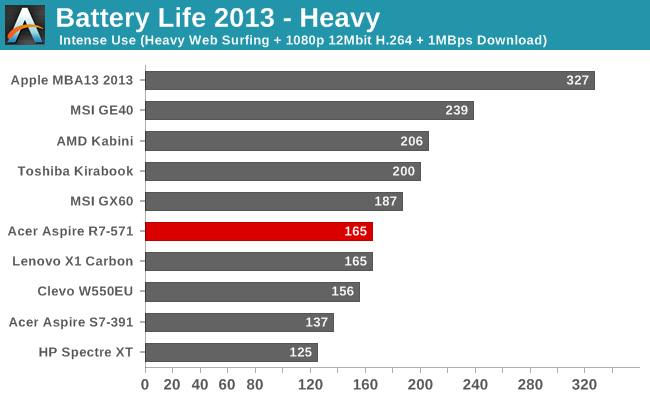
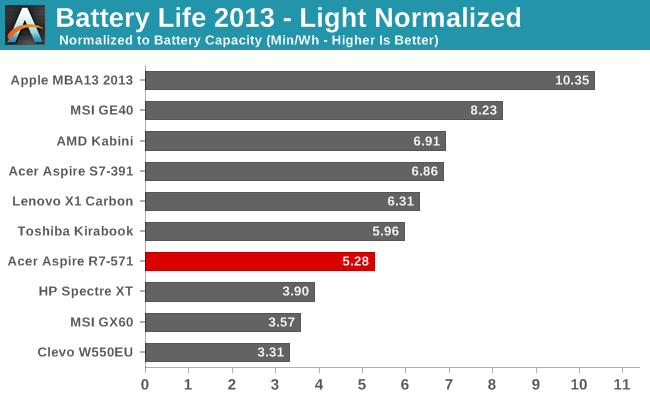
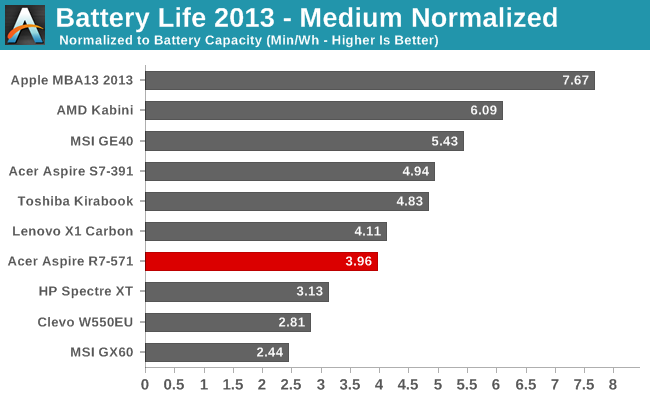
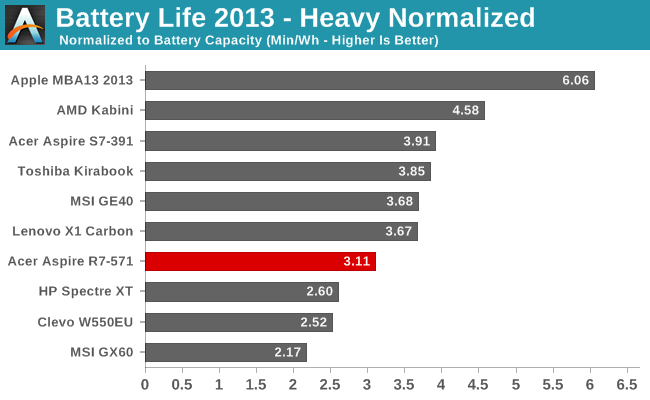
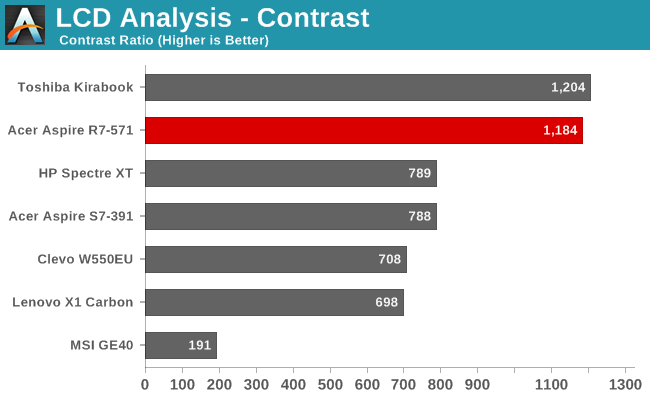

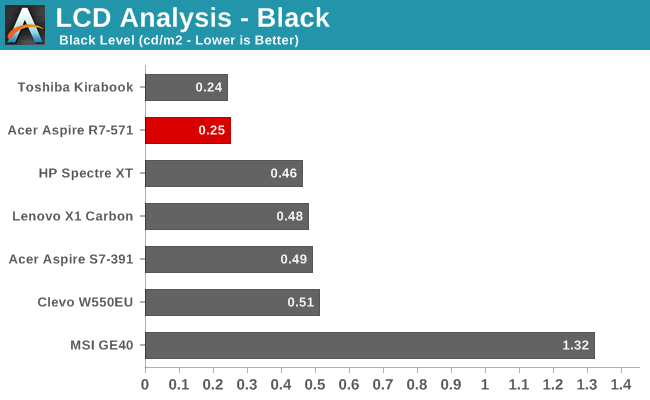
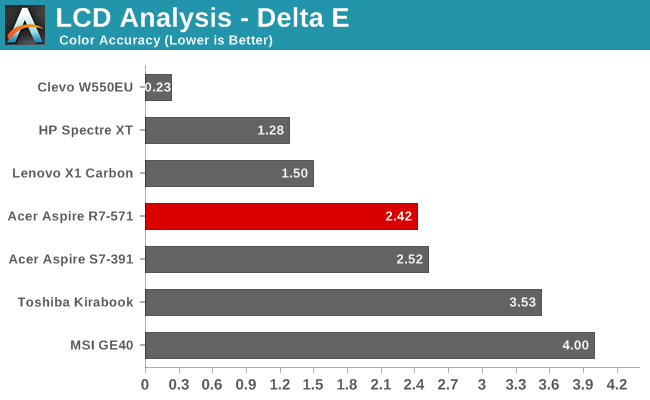
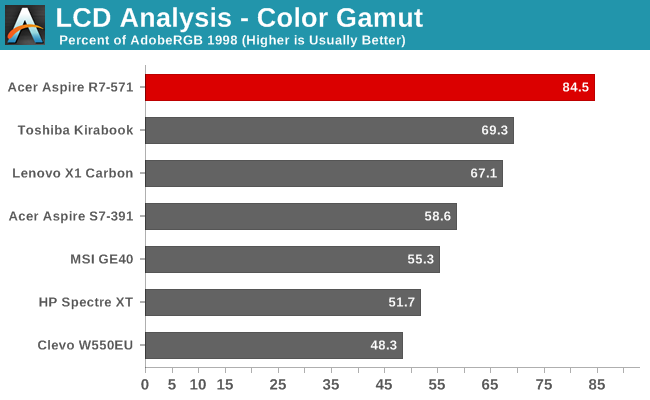
Whew! That’s a lot of benchmarks, and there are even more results in Mobile Bench – like if you really want to know how the R7 handles our gaming suite, for example, it’s there! If you don’t want to look but want a short summary, only one game gets above 10FPS at the Enthusiast settings, and just barely; with Mainstream most of the games fall in the 10-20FPS range, so basically unplayable. Even our Value gaming settings are mostly too much for the HD 4000, though most of the Windows 8 games in the Store are far less demanding and will run just fine – no surprise given most of those are targeting Windows RT, which means GPUs that are often less than half as fast as the HD 4000.
Elsewhere, CPU performance is about where you’d expect it: lower than Core i7 ULV/ULT, and similar to other Core i5 ULV parts. The hybrid storage solution means that PCMark7 doesn’t score quite as well as pure SSDs, but it’s still a huge step up from what you’d get from a pure HDD setup (e.g. GX60). Since I just mentioned the GX60, it’s also interesting to note that Core i5 ULV generally posts better CPU performance than AMD’s Richland APUs – though the second pass of x264 HD at least put AMD slightly ahead. GPU performance is nothing to write home about; it’s more than sufficient for running most Windows tasks, but anything graphically intensive is best off served by a dedicated GPU (or at the very least Intel’s Iris HD Graphics Iris Pro).
Battery life isn’t particularly stellar, but we’ve also seen worse – sometimes much worse. Realistically, four hours of light use is possible off a single charge, while heavier workloads will bring you closer to 2.5 hours. That puts the R7 slightly ahead of the Lenovo X1 Carbon in most tests, but only thanks to its higher battery capacity. In terms of normalized battery life, the R7 places fourth from last of the tested notebooks, and given that Clevo typically doesn’t optimized very well for power use and the MSI GX60 is classified as a gaming notebook, only the win over the HP Spectre XT TouchSmart is really worth mentioning. When we start to look at Haswell-based notebooks, even though Ivy Bridge was pretty good it looks pretty poor in light of what’s now available. Apple’s MacBook Air 13 runs at different OS, but the MSI GE40 has a quad-core Haswell CPU and a slightly larger battery, with about 50% more battery life than the Acer R7.
Wrapping up the benchmarks, as I mentioned before, the one standout item in the R7 is the display. Contrast is excellent, and color quality is at least decent – the 85% color gamut is actually a bit overblown, however, as some of the colors are actually outside of the Adobe RGB 1998 color space while others fall far short (green in particular is lacking). Still, the great viewing angles offered by AHVA combined with good overall performance definitely deserve commendation.










113 Comments
View All Comments
max1001 - Thursday, August 15, 2013 - link
Considering Windows 8 tablets are only a year old, not really a fair comparison is it?Da W - Thursday, August 15, 2013 - link
Most Android tablets are cheap ass Nexus 7 or Amazon kindle fire selling for Under 200$. Of course they sell, it doesn't mean it's better. With the same logic you could argue that McDonald outclasses every goddam 5 stars restaurants you can think of and that a Kraft Dinner and a Coke is the best meal on the planet a human can cook.Da W - Thursday, August 15, 2013 - link
And with Apple raking in 90% of smartphone/tablet profits, with only 15% of sales, one could argue Google is doing anticompetitive behavior called predatory pricing. They are flooding the market with a free OS and cheap hardware priced at cost, so that everybody uses Google advertising services in the future. At it's heart its illegal. The FTC/DOJ is far less effective than it used to be, but there have been many other firms that were proven guilty of comparable things back in the days, (when the bureaucrats actually worked...)fluxtatic - Saturday, August 17, 2013 - link
Seriously? No, the difference is that Apple is a hardware company. That is, they don't really care about iOS or OSX except to the extent that it helps them sell hardware, which they make huge profits on. Google doesn't have the same model - they're an advertising company and if they want to sell hardware cheap in order to widen the market for their profit center (advertising), Apple can't cry to the DOJ about it.Remind me again, who was it that just lost a price-fixing lawsuit?
JarredWalton - Saturday, August 17, 2013 - link
Doesn't Apply make more money on iTunes than they do on hardware?thesavvymage - Monday, August 19, 2013 - link
That isnt predatory pricing. Predatory pricing is lowering your prices to sell at a loss when a competitor opens up nearby, driving them out of business QUICKLY, then raising your prices back up. Giving away a product for free or having cheap priced goods ALL the time (such as Walmart) is not predatory pricing.fluxtatic - Saturday, August 17, 2013 - link
Dude, 17-year-old me would have told you a Coke and a box of Kraft Macaroni and Cheese was the best meal.OoklaTheMok - Tuesday, August 20, 2013 - link
You sir, are absolutely correct. So many android devices (phone & tablet) are disposable. No software support, poor durability... Etc. Comparing sales numbers only tells you a small part of the overall picture.CharonPDX - Thursday, August 15, 2013 - link
Try again - Apple sold 22.9 million iPads in Q4 of 2012, and the ENTIRE COMPUTING INDUSTRY only sold 134 million - that is desktop PCs, laptops, and tablets, including the iPad.That means in Q4 of 2012, the iPad alone was 16% of the "PC" market. http://www.pcmag.com/article2/0,2817,2415180,00.as...
By some estimates, next year tablets will outsell conventional PCs.
Yes, Windows outsells OS X by a huge margin, and Android outsells iOS by a large margin (8;2? Why not say 4:1?) But iPad still outsells all other tablets, and by itself the iPad outsells all of the next-highest-production non-phone computing COMPANY. (HP sells the most PCs worldwide - Apple sold more iPads than HP sold COMPUTERS in Q4 2012 per my previous link.)
So if current trajectories hold, iOS will be the biggest OS in the world by 2015. Although I doubt those trajectories will hold, Android is starting to chip away at iOS' tablet market share. But even so, by 2016, the iPad may outsell all "PCs" combined.
Sarav - Friday, August 16, 2013 - link
Hasn't Android tablet market share already overtaken iOS (Ipad's) market share? Granted Apple will most likely regain the lead again in Q4 this year, but Android phones outsell iOS based phones by such a margin that I just can't comprehend how iOS will be the largest OS in 2015.